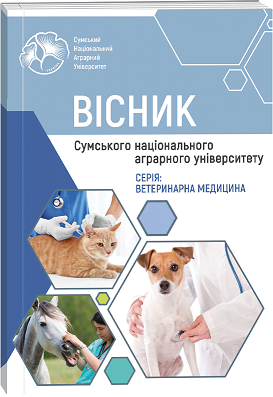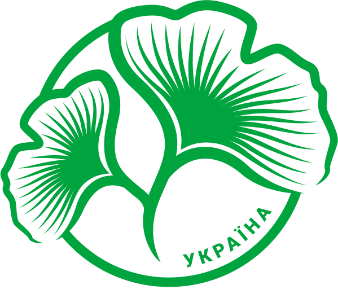COMPARISON OF THE DYNAMICS OF MICROFLORA RESTORATION IN ROOMS FOR PIGS KEEPING AFTER DISINFECTION WITH “VULCAN MAX” AND “SVITECO PIP MULTI”
Abstract
The article presents the results of a study of the dynamics of microflora recovery in pig housing facilities after disinfection with the «Sviteco PIP Multi» and «Vulcan Max» agents. It was found that the recovery of microorganisms occurred within the first 3 hours after their application. «Sviteco PIP Multi», which contains probiotics Bacillus subtilis and Bacillus megaterium, provided a significantly higher level of microbial load at this study stage. On the floor of the premises, the total number of mesophyllic aerobic and facultative anaerobic microorganisms (MAFAnM) was 7.07±0.11 log CFU/cm³ of washout, which exceeded the similar indicator for «Vulcan Max» by 3.9 times (p<0.001). However, the leading representatives of the isolated microflora were bacilli, the share of which reached 99.7% of the total MAFAnM. In the following periods of the study (6, 24, 48, and 72 hours), when using «Sviteco PIP Multi» a minimal increase in MAFAnM was noted (by 1.4–3.6%), while when using «Vulcan Max», this indicator increased significantly (p<0.05–p<0.001), reaching 47.8% after 6 hours and 79.1% after 24 hours. At the end of the production cycle, the total number of MAFAnM on the floor when using «Sviteco PIP Multi» was 4.5% lower than after using «Vulcan Max» (6.57±0.12 versus 6.88±0.05 log CFU/cm³ of washout), while bacilli were 47.1 and 29.7%, respectively. The trends in restoring microflora were similar on intercellular partitions and walls of premises. Three hours after disinfection, the number of MAFAnM for «Sviteco PIP Multi» was 6.68±0.13 log CFU/cm³ of washout on partitions and 6.69±0.05 log CFU/cm³ of washout on walls, which significantly (p<0.001) exceeded the indicators of «Vulcan Max». The number of bacilli was also higher when using «Sviteco PIP Multi» and was 98.9–99.4% versus 42.8–92.1% for «Vulcan Max». On feeders after disinfection with "Sviteco PIP Multi," the total number of MAFAM after 3 hours was 6.52±0.04 log CFU/cm³, which was 4.7 times (p<0.001) higher than the indicator of "Vulcan Max." Over the next 72 hours, the number of MAFAM increased by 3.9 times (p<0.001) with "Vulcan Max," while when using "Sviteco PIP Multi," it remained stable or slightly decreased. The results obtained indicate the antagonistic activity of the "Sviteco PIP Multi" product against nonspore- forming microorganisms, which occurs due to the simultaneous contact of probiotic bacilli spores with the disinfectant on the surface, their rapid colonization of the ecological niches released by the action of the disinfectant, and the creation of competitive conditions for the development of other microflora.
References
2. Celandroni, F., Vecchione, A., Cara, A., Mazzantini, D., Lupetti, A., & Ghelardi, E. (2019). Identification of Bacillus species: Implication on the quality of probiotic formulations. PloS one, 14(5), e0217021. https://doi.org/10.1371/journal. pone.0217021
3. D’Accolti, M., Soffritti, I., Bini, F., Mazziga, E., Mazzacane, S., & Caselli, E. (2022). Pathogen control in the built environment: a probiotic-based system as a remedy for the spread of antibiotic resistance. Microorganisms, 10(2), 225. 10.3390/microorganisms10020225
4. Denkel, L. A., Voss, A., Caselli, E., Dancer, S. J., Leistner, R., Gastmeier, P., & Widmer, A. F. (2024). Can probiotics trigger a paradigm shift for cleaning healthcare environments? A narrative review. Antimicrobial Resistance & Infection Control, 13(1), 119. https://doi.org/10.1186/s13756-024-01474-6
5. Ding, S., Yan, W., Ma, Y., & Fang, J. (2021). The impact of probiotics on gut health via alternation of immune status of monogastric animals. Animal Nutrition, 7(1), 24-30. https://doi.org/10.1016/j.aninu.2020.11.004
6. Green, L. H., & Goldman, E. (Eds.). (2021). Practical handbook of microbiology. CRC press. https://doi.org/10.1201/9781003099277
7. Iakubchak, O. M., Kovalenko, V. L., Khomenko, V. I., Denysiuk, H. M., Bondar, T. O., & Midyk, S. V. (2005). Rekomendatsii shchodo sanitarno-mikrobiolohichnoho doslidzhennia zmyviv z poverkhon test-obiektiv ta obiektiv veterynarnoho nahliadu i kontroliu: metodychni rekomendatsii. [Recommendations for the sanitary-microbiological study of washings from surface test objects and objects of veterinary supervision and control: methodological recommendations] Kyiv: NAU. [in Ukrainian].
8. Khoroshun, E. M., Volkova, Y. V., Makarov, V. V., Nehoduiko, V. V., Shipilov, S. A., Baranova, N. V., & Bondarenko, V. V. (2024). Analiz vplyvu kombinatsii probiotychnykh kultur Bacillus na rezultaty likuvannia khvorykh z boiovoiu travmoiu u viddilenniakh intensyvnoi terapii. [Analysis of the effect of combinations of Bacillus probiotic cultures on treatment outcomes in patients with combat trauma in the intensive care units]. EMERGENCY MEDICINE, 20(1), 26-34. [in Ukrainian] https://doi.org/10.22141/2224-0586.20.1.2024.1655
9. Komisarova, D., Bondar A., Lumedze T., & Lumedze I. (2023). Dezinfektsiia u tvarynnytskomu prymishchenni. [Disinfection in livestock premises]. Ahrarnyi visnyk Prychornomoria, (108). [in Ukrainian] https://doi.org/10.37000/abbsl.2023.108.10
10. Liasota, V. P., Bukalova, N. V., Bohatko, N. M., Mazur, T. H., Khitska, O. A., Dzhmil, V. I., ... & Prylipko, T. M. (2022). Hihiienichne obgruntuvannia vykorystannia absorbentu Polifan-K za vyroshchuvannia svynei. [Hygienic justification for the use of the absorbent Polifan-K when raising piglets]. Naukovyi visnyk veterynarnoi medytsyny. 2, 6–19. [in Ukrainian] https://doi.org/10.33245/2310-4902-2022-176-2-6-19
11. Luise, D., Bosi, P., Raff, L., Amatucci, L., Virdis, S., & Trevisi, P. (2022). Bacillus spp. probiotic strains as a potential tool for limiting the use of antibiotics, and improving the growth and health of pigs and chickens. Frontiers in Microbiology, 13, 801827. https://doi.org/10.3389/fmicb.2022.801827
12. Makovska, I., Chantziaras, I., Caekebeke, N., Dhaka, P., & Dewulf, J. (2024). Assessment of Cleaning and Disinfection Practices on Pig Farms across Ten European Countries. Animals, 14(4), 593. https://doi.org/10.3390/ani14040593
13. Myronchuk, V., & Peleno, R. (2023). Retrospektyvnyi analiz vyrobnytstva osnovnykh diiuchykh rechovyn ta asortymentu dezinfikuiuchykh zasobiv v Ukraini. [Retrospective analysis of production of ma. in active ingredients and assortment of disinfectants in Ukraine.]. Scientific Messenger of LNU of Veterinary Medicine and Biotechnologies. Series: Veterinary Sciences, 25(110), 69-75. [in Ukrainian]. https://doi.org/10.32718/nvlvet11011
14. Nebelytsia M. S., Boiko O. V., Havrysh O. M., Sotnichenko Yu. M. (2023) Multyparametrychna otsinka mikroklimatu svynarnykiv za riznykh paratypovykh faktoriv. [Mathematical assessment of the microclimate of pig farms under various paratypic factors]. Svynarstvo i ahropromyslove vyrobnytstvo : mizhvidom. temat. nauk. zb. In-t svynarstva i APV NAAN. Poltava, 2(80), 87-101. [in Ukrainian]. https://doi.org/10.37143/2786-7730-2023-2(80)06
15. Opryshko, V. I., Prokhach, A. V., Prokhach, A. V., & Kurt-Ametova, H. S. (2021). Dyvovyzhne poruch. Efektyvnyi i bezpechnyi zakhyst vid vnutrishnolikarnianykh infektsii. Neonatolohiia, khirurhiia ta perynatalna medytsyna [Amazing help. Effective and safe protection against nosocoacquisitions]. Neonatology, Surgery and Perinatal Medicine, 11(1), 73-76. [in Ukrainian] .https://doi.org/10.24061/2413-4260.XI.1.39.2021.10
16. Ovuru, K. F., Izah, S. C., Ogidi, O. I., Imarhiagbe, O., & Ogwu, M. C. (2024). Slaughterhouse facilities in developing nations: Sanitation and hygiene practices, microbial contaminants and sustainable management system. Food Science and Biotechnology, 33(3), 519-537. https://doi.org/10.1007/s10068-023-01406-x
17. Ramos, A. M., & Frantz, A. L. (2023). Probiotic-based sanitation in the built environment—an alternative to chemical disinfectants. Applied Microbiology, 3(2), 536-548. https://doi.org/10.3390/applmicrobiol3020038
18. Scollo, A., Perrucci, A., Stella, M. C., Ferrari, P., Robino, P., & Nebbia, P. (2023). Biosecurity and hygiene procedures in pig farms: Effects of a tailor-made approach as monitored by environmental samples. Animals, 13(7), 1262. https://doi.org/10.3390/ani13071262
19. Spratt, H. G., Millis, N., Levine, D., Brackett, J., & Millis, D. (2024). Bacterial Contamination of Environmental Surfaces of Veterinary Rehabilitation Clinics. Animals, 14(13), 1896. https://doi.org/10.3390/ani14131896
20. Tang, X., Zeng, Y., Xiong, K., & Zhong, J. (2024). Bacillus spp. as potential probiotics: promoting piglet growth by improving intestinal health. Frontiers in Veterinary Science, 11, 1429233. https://doi.org/10.3389/fvets.2024.1429233

 ISSN
ISSN  ISSN
ISSN 



